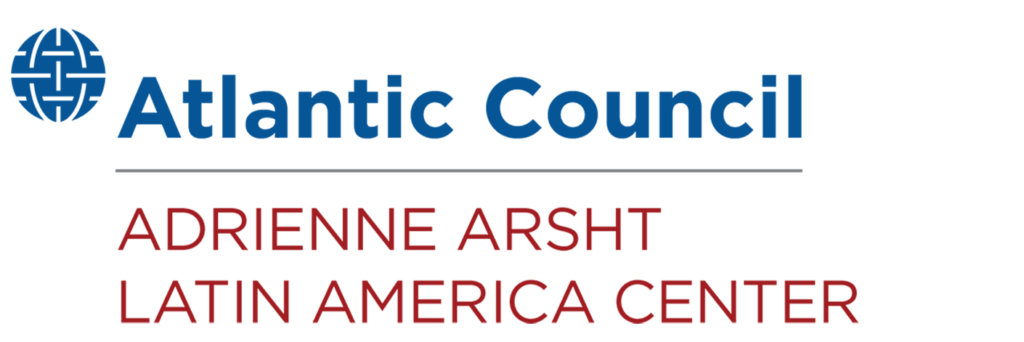Counter new strategic challenges
THE YEAR 2022 IS AN IMPORTANT ONE for the United States and Colombia: the 200th anniversary of formal diplomatic relations between our countries. Beyond simply marking the rich history of two centuries, this is an excellent time to examine our relationship in the context of current global affairs and look for ways to further strengthen it.
In my time in Congress and as co-chair of the Atlantic Council’s US-Colombia Task Force, I have been proud to lead and support many of the initiatives that have strengthened US relations with Colombia. Our joint efforts have boosted our economies and helped lay the groundwork for institutional growth, security, and peace-building in Colombia.
This has made a real difference for Colombia. Since 2000, Congress has directed roughly $12 billion in bilateral aid to support the country’s economic development, conflict resolution, and counter-narcotics efforts.1June S. Beittel, Colombia: Background and U.S. Relations, Congressional Research Service, updated December 16, 2021, https://crsreports.congress.gov/product/pdf/R/R43813. As a result, Colombia’s economy began to evolve into what it is today: an open and growing market-based economy ripe with opportunity.
Colombia’s progress will help unlock an even stronger relationship between our countries. We look to this increased stability and economic growth to serve as a bulwark against emerging threats to democratic values. As the oldest democracy in Latin America, Colombia will be an excellent partner in countering the influence of our competitors.
Chief among these competitors is China, which has used its economic strength for coercion and to strengthen its military power. China’s Belt and Road Initiative (BRI), initially targeting the Indo-Pacific region, has now expanded to reach more than 130 countries, amounting to 40 percent of global GDP and more than 63 percent of the world’s population.2David Sacks, “Countries in China’s Belt and Road Initiative: Who’s In And Who’s Out,” Council on Foreign Relations, March 24, 2021, https://www.cfr.org/blog/countries-chinas-belt-and-road- initiative-whos-and-whos-out. In 2017, four years after the program was launched, China announced that Latin America was a “natural extension” of the BRI and would facilitate “a community of shared future for China and Latin America.”3Consulate-General of the People’s Republic of China in Johannesburg, “Wang Yi: The Belt and Road Initiative Becomes New Opportunity for China-Latin America Cooperation,” September 18, 2017, https://www.fmprc.gov.cn/ce/cgjb/eng/xwdt/zgyw/t1494844.htm. Panama became the first Latin American country to join, and more than twenty of the region’s thirty-three countries have followed.4Pepe Zhang, Atlantic Council, “Issue Brief: Belt and Road in Latin America: A regional game changer?,” October 8, 2019, https://www.atlanticcouncil.org/in-depth-research-reports/issue- brief/belt-and-road-in-latin-america-a-regional-game-changer/; and China’s Engagement with Latin America and the Caribbean, Congressional Research Service, updated February 24, 2022, http:// sgp.fas.org/crs/row/IF10982.pdf.
The expansion of the BRI into Latin America is typical of a larger trend of increasing connection between China and the Western Hemisphere. Total trade between China and Latin America increased from $18 billion in 2002 to $318 billion in 2020. China is now the largest trading partner of Brazil, Chile, Peru, and Uruguay and the second largest for many other countries, including Colombia, where trade with China fell short of US trade in goods by only $109 million in 2020.5China’s Engagement with Latin America and the Caribbean, Congressional Research Service. 6International Trade Administration, “Colombia Country Commercial Guide,” US Department of Commerce, November 8, 2021, https://www.trade.gov/knowledge-product/exporting-colombia- market-overview.
China has displayed the ability and the intent to use its economic power to expand its influence, broaden its military footprint, and attempt to coerce its “partners” to fall in line on issues like human rights abuses, isolating Taiwan, and China’s antagonistic activity on the world stage.
According to the US-China Economic and Security Review Commission, while economic interests remain the primary driver of China’s engagement in Latin America, its standing as a top trading partner, lender, and investor gives it a great deal of power over other governments. The commission reports that China “[encourages] Latin American and Caribbean governments to make domestic and foreign policy decisions that favor China while undermining democracies and free and open markets.”7United States-China Economic and Security Review Commission, “Section 2: China’s Influence in Latin America and the Caribbean,” November 2021, https://www.uscc.gov/sites/default/files/2021- 11/Chapter_1_Section_2–Chinas_Influence_in_Latin_America_and_the_Caribbean.pdf. The United States must remain mindful of the consequences of China acquiring this much political and economic leverage in Latin America.
While Colombia has remained outside the BRI, Chinese investment in Colombia has increased. State-owned firms have inked deals to construct and operate Bogotá’s first metro system and hydroelectric power plants and purchased a large gold mine.8Michael Stott, “Foreign investment in Colombia holds firm, says trade minister,” Financial Times, October 7, 2020, https://www.ft.com/content/9fa69fba-a4a2-48bc-a928-ef5c1793fe9b. Notably, no US firms placed bids on the metro system project or on any of Colombia’s large road projects in the past six years.9Atlantic Council US-Colombia Task Force, A Plan for Colombia’s COVID-19 Recovery and Why it Matters, Atlantic Council’s Adrienne Arsht Institute, December 2021, https://www.atlanticcouncil.org/wp-content/uploads/2021/12/AC_ColombiaTaskForce_v18.pdf. Given China’s propensity to use these types of investments for its objectives, the United States should strengthen economic ties with Colombia, increase investment in the country’s future, and help it resist any attempts to undermine its democratic values.
The United States should continue to deepen bilateral trade with Colombia via the existing US-Colombia Trade Promotion Agreement (TPA). As a member of Republican leadership in the US House of Representatives during the George W. Bush administration, I helped start the trade agreement negotiations. As a senator, I helped give it the final push into law. When the agreement entered into force in May 2012, it immediately lifted tariffs on more than 80 percent of US exports of consumer and industrial products to Colombia, with the remainder lifted over ten years. On the tenth anniversary of this landmark agreement, the United States should reinvigorate its trade relationship with Colombia to ensure we remain the country’s top partner and that the agreement continues to create jobs and economic opportunities in both countries. In addition, the TPA could be better leveraged to advance nearshoring opportunities as it provides US companies with a stable and predictable trade and investment environment. US companies seeking to relocate their supply chains closer to their main markets should take advantage of the agreement’s friendly investment chapter and rules of origin provision as well as Colombia’s geographic proximity to the United States. Another way the United States could deepen our economic ties and reduce dependence on China is through nearshoring. The COVID- 19 pandemic and China’s destabilizing maritime activities in the Indo-Pacific have raised alarms about supply chain resiliency and the risks of heavily relying on China for key exports. A 2020 survey by financial services firm UBS found that 71 percent of manufacturers planned to move some of their production out of China.10“China Economic Perspectives: CFOs’ take on COVID-19 impact,” October 28, 2020, UBS Investment Bank, https://www.ubs.com/global/en/investment-bank/in-focus/covid-19/2020/cfos-take.html. Moving US supply chains from China to regional partners like Colombia would diminish this reliance while boosting jobs and business opportunities.
The Inter-American Development Bank (IDB) has begun taking steps to finance and otherwise encourage nearshoring to Latin America. In 2021, the IDB worked with sixteen Latin American countries to identify criti- cal export and supply-chain advantages of nearshoring.11“IDB and IDB Invest Close Year with Nearly $20 Billion in New Financing for Latin America & Caribbean,” IDB Invest, December 20, 2021, https://www.idbinvest.org/en/news-media/idb-and-idb-invest-close-year-nearly-20-billion-new-financing-latin-america- caribbean#:~:text=The%20Inter%2DAmerican%20Development%20Bank,of%20su- stainable%20and%20inclusive%20growth. ProColombia, the government agency tasked with promoting Colombian exports, tourism, and investments, maintains a website identifying key sectors with investment opportunities, including agricultural products, energy, manufacturing, health care services, and information technology.12“Investment Sectors,” Colombia Co., accessed March 1, 2022, https://investincolombia.com.co/en/sectors.
These are critical steps in jumpstarting investment, but there is room for additional US support for nearshoring and investment. The US government should facilitate public-private collaboration and work with both the private sector and the Colombian government to identify and overcome barriers to investing and nearshoring. We should reevaluate the tools at our disposal, such as the International Development Finance Corporation, and find more ways to support these opportunities in countries like Colombia that support our national security and foreign policy priorities.
The expansion of competition in the Western Hemisphere also presents opportunities for US-Colombia relations to preserve security and stabil-ity. In addition to its economic influence, China collaborates with repressive authoritarians, such as the Nicolás Maduro regime in Venezuela, and enables anti-democratic behavior in other countries. Of particular concern is China’s exportation of digital and surveillance technologies, which allow more regimes to surveil and repress critics and minority populations.13United States-China Economic and Security Review Commission, “Section 2: China’s Influence in Latin America and the Caribbean.”
In 2021, we saw widespread democratic backsliding in Latin America. Authoritarians consolidated their power, and more Latin Americans became indifferent or disillusioned with democracy. Colombia saw its own mass protests in 2021, with the effects of the COVID-19 pandemic exacerbating longstanding societal tensions. Colombia needs US partnership now more than ever to support effective governance and institutional capacity and to prevent Colombia from falling victim to the political turmoil taking place throughout the region.
International enablers of the Maduro regime have exacerbated the crisis in Venezuela, generating a mass exodus. Colombia’s acceptance of nearly two million migrants and refugees has been a stabilizing force in this crisis, but the government needs more support given the challenges it already faces.14“Supporting Colombian Host Communities and Venezuelan Migrants During the COVID-19 Pandemic, World Bank, October 31, 2021, https://www.worldbank.org/en/results/2021/10/31/supporting-colombian-host-communities-and-venezuelan-migrants-during-the-covid-19-pandemic#:~:text=As%20of%20March%202021%2C%20an,70%20%25%20of%20all%20Venezuelan%20migrants.
Colombia needs more resources to support the initiative launched last year that will provide temporary protective status to Venezuelan migrants, allowing them to access healthcare and other essential services. The COVID-19 pandemic added another layer of complexity, necessitating a vaccination campaign for Colombian citizens and Venezuelans to reduce the virus’s spread.
The United States should also build upon existing cooperation with Colombia on security, safety, and countering illicit activity. It’s no coincidence that Colombia’s economic growth accompanied a reduction in violence. We should continue strong support for Colombia’s coca eradication and counter-narcotics efforts, including building state capacity in isolated regions and facilitating crop substitution. These programs help stem the production of drugs and associated violence, and they also help underserved communities gain access to state services to begin building economic prosperity. For the United States, these programs target supply sources of the drug crisis that brings despair to our communities.
A lot has changed in Colombia since I worked to pass the legislation for Plan Colombia and since Senator Ben Cardin and I became co-chairs of the Atlantic Council’s Colombia Task Force. What has not changed is the critical role that Colombia plays in the Western Hemisphere and worldwide as a symbol of democratic persistence and economic openness. I look forward to Colombia’s continued growth. I believe that more cooperation between our countries makes us both stronger, more prosperous, and more secure as we start the third century of the formal bond between our countries.
* * *
Senator Roy Blunt (R-MO) has been a US senator for Missouri since being elected in 2010. Blunt chairs the Senate Republican Policy Committee, serves as the top Republican on the Senate Rules Committee, and is a member of the Senate Defense Appropriations Subcommittee. Blunt co-chairs the non- partisan Atlantic Council US-Colombia Task Force alongside Senator Ben Cardin.
Related Allies essays
A roadmap for a new type of engagement
This moment opens the door for a reimagined US partnership with Colombia based on a shared vision for a more prosperous, inclusive, and sustainable future.
Related program

The Adrienne Arsht Latin America Center broadens understanding of regional transformations and delivers constructive, results-oriented solutions to inform how the public and private sectors can advance hemispheric prosperity.
Image: U.S. President Joe Biden meets with Colombia's President Ivan Duque in the Cabinet Room at the White House, in Washington, U.S., March 10, 2022. REUTERS/Jonathan Ernst
